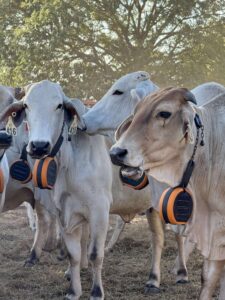Virtual fencing in the NT

Imagine being able to muster and manage where your cows graze from your smartphone?…
This may not be a far fetched idea for much longer, because the first virtual fencing demonstration has landed in the Northern Territory!
Using the Gallagher eShepherd collars, the Livestock Industries team from the Northern Territory Department of Agriculture & Fisheries is investigating the viability of virtual fencing in the remote and often harsh environments of the Territory rangelands. They will be determining the effectiveness of using virtual fencing (VF) to manage grazing behaviour under several scenarios in the NT.
Training & collar application
In the first use of the technology, VF collars have been deployed on 45 cows at Victoria River Research Station in the Victoria Rver District (approx. 650km south-west of Darwin). A 12 day training period took place to allow the cows to become accustomed to the collars and learn about the audio and pulse cues that indicate a virtual fence boundary. The initial training took place in a small, cleared paddock, where the animals could interact with the virtual fence in a controlled environment and their interactions with the virtual fence could be closely controlled and observed by the research team.

It was important during the training period to include the water point and adequate pasture in the virtual fenced area. Once all of animals that had interacted with the virtual fence in the training paddock, the VF was turned off while they were walked out to their designated paddock for the remainder of the trial. The paddock is 681ha, with a 250ha exclusion zone within the paddock. The exclusion zone is a “scald” that usually gets overgrazed. The aim is to keep cattle within the boundary of the paddock but out of the exclusion zone for the duration of the trial.
Next steps in the virtual fencing demonstration
The VF technology will be trialled in other areas, with different aims. At one site, 100 cows in a paddock will be fitted with collars and VF will be used to get them to stay near a new water point in the paddock. At another site, VF will be used to manage strip grazing under a pivot irrigator.
Keep an eye out for project updates!
Other considerations
Only animals that are over 200kg should be fitted with collars as the collars are quite large (2.1kg). The collars cost around $350 +GST each and a base station is required in areas without mobile phone coverage. The range of the base station varies with terrain, vegetation and tower height.
Key contact:
Email: Christie.Pearson@nt.gov.au